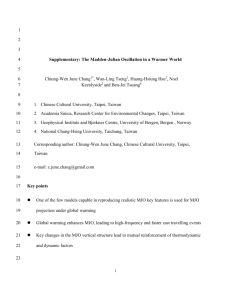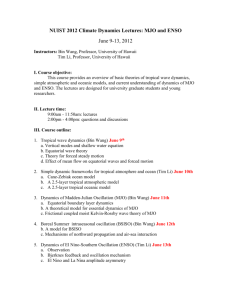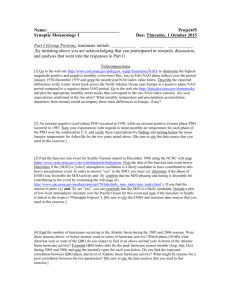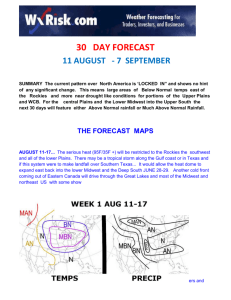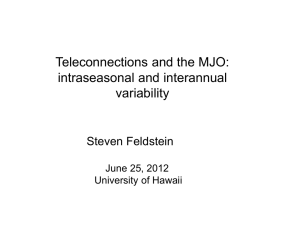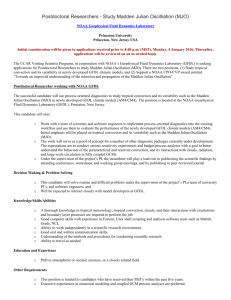Tian_ECyy - California Institute of Technology
advertisement
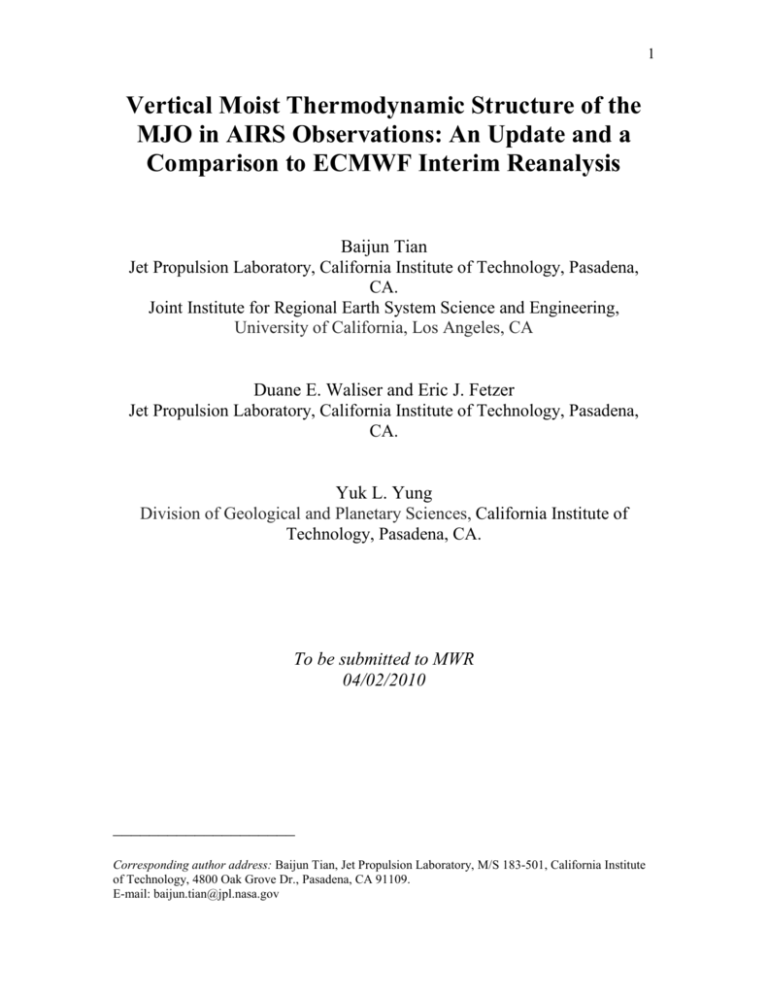
1 Vertical Moist Thermodynamic Structure of the MJO in AIRS Observations: An Update and a Comparison to ECMWF Interim Reanalysis Baijun Tian Jet Propulsion Laboratory, California Institute of Technology, Pasadena, CA. Joint Institute for Regional Earth System Science and Engineering, University of California, Los Angeles, CA Duane E. Waliser and Eric J. Fetzer Jet Propulsion Laboratory, California Institute of Technology, Pasadena, CA. Yuk L. Yung Division of Geological and Planetary Sciences, California Institute of Technology, Pasadena, CA. To be submitted to MWR 04/02/2010 ____________________ Corresponding author address: Baijun Tian, Jet Propulsion Laboratory, M/S 183-501, California Institute of Technology, 4800 Oak Grove Dr., Pasadena, CA 91109. E-mail: baijun.tian@jpl.nasa.gov 2 Abstract We documented the large-scale vertical moist thermodynamic structure of the Madden-Julian Oscillation (MJO) using the first 2.5 years (2002-2005; 8 MJO events) of verison 4 atmospheric specific humidity and temperature profiles from the Atmospheric Infrared Sounder (AIRS) (Tian et al. 2006). Here, we further examine this issue using currently available 7-year verion 5 AIRS data (2002-2009; 17 MJO events) to test its dependence on the AIRS data records, versions and MJO event selection and compositing method employed. Our results indicate a strong consistency of the large-scale vertical moist thermodynamic structure of the MJO between different AIRS data records (2.5 versus 7 years), versions (4 versus 5) and different MJO event selection and compositing methods (the extended empirical orthogonal function (EEOF) method used by Tian et al. (2006) versus the multivariate empirical orthogonal function (MEOF) method used by Wheeler and Hendon (2004)). We also compare the large-scale vertical moist thermodynamic structures of the MJO between AIRS and the ECMWF Interim reanalysis (ERA-Interim). Our results indicate a much better agreement of the MJO structure between ERA-Interim and AIRS than NCEP/NCAR reanalysis, although ERA-Interim are much moister (~20%) in moist regions and much drier (~20%) in dry regions compared to AIRS. These results will provide a useful metric for climate model diagnostics and MJO theory validation. 1. Introduction The Madden-Julian Oscillation (MJO) (Madden and Julian 1971, 1972) is the dominant form of intraseasonal (30–90 day) variability in the tropical atmosphere. The MJO interacts with, and influences, a wide range of weather and climate phenomena 3 (e.g., monsoons, El Niño-Southern Oscillation, tropical hurricanes, and extra-tropical weather), and represents an important source of predictability at the subseasonal time scale (Lau and Waliser 2005; Zhang 2005). However, the MJO is still not well understood (e.g., Wang 2005; Waliser 2006) nor well represented in global climate models (e.g., Slingo et al. 2005; Lin et al. 2006; Zhang et al. 2006). Recently available satellite data have provided an excellent opportunity to study the MJO, especially its vertical structure (e.g., Myers and Waliser 2003; Fu et al. 2006; Tian et al. 2006; Yang et al. 2008). For example, Tian et al. (2006) have documented the large-scale vertical moist thermodynamic structure of the MJO using the first 2.5-year (2002-2005; only 8 MJO events) Version 4 (V4) atmospheric specific humidity and temperature profiles from the Atmospheric Infrared Sounder (AIRS) on the NASA Aqua mission. Here, we further examine this issue using the currently available 7 years of Version 5 (V5) AIRS data (2002-2009, 17 MJO events) to test the robustness of our earlier results (Tian et al. 2006) and their dependence on the AIRS data records, versions and MJO event selection and compositing methods employed. Our earlier study also compared the large-scale vertical moist thermodynamic structures of the MJO between AIRS and National Centers for Environmental Prediction (NCEP)/National Center for Atmospheric Research (NCAR) reanalysis, with the indication that NCEP/NCAR analysis was deficient in a number of areas, particularly in the Indian and Pacific Oceans. In this study, we perform a similar comparison between AIRS and the European Centre for Medium-Range Weather Forecasts (ECMWF) Interim reanalysis (ERA-Interim), a new global reanalysis data set from ECMWF, to evaluate the performance of ERA-Interim in describing the large-scale vertical moist thermodynamic structure of the MJO. 4 2. Data Three data sets were used for this study. The first is the global, daily (arithmetic mean of ascending and descending nodes) AIRS V5 Level 3 atmospheric temperature and specific humidity profiles for the period of September 2002 to July 2009. The AIRS data have a horizontal 1° x 1° resolution and are on 24 pressure levels from 1000 hPa to 1 hPa for temperature and 12 pressure layers from 1000 hPa to 100 hPa for specific humidity (Chahine et al. 2006). The second is the global, daily (arithmetic mean of 4xdaily) ERAInterim atmospheric temperature and specific humidity profiles for the same period as the AIRS data. The ERA-Interim data have a horizontal 1.5° x 1.5° resolution and are on 37 pressure levels from 1000 to 1 hPa. The ERA-Interim assimilates cloud-screened radiances but not temperature and water vapor retrievals from AIRS since April 2003 (Frederic Vitart, personal communication). The third is the Tropical Rainfall Measurement Mission (TRMM) 3B42 Version 6 rainfall data from January 1st, 1998 to June 30th, 2009. The TRMM 3B42 data extends globally from 50°S to 50°N on 0.25° x 0.25° grid boxes every 3 hours (Huffman et al. 2007). 3. MJO analysis methods Two MJO analysis methods (e.g., MJO event selection and compositing procedures) were employed for this study. Method 1 is the MJO analysis method used by Waliser et al. (2003) and Tian et al. (2006) and will be referred to as extended empirical orthogonal function (EEOF) method in this paper. Briefly, all data were first binned into pentad (5-day) values and intraseasonal anomalies of the pentad data were obtained by removing the climatological seasonal cycle and filtering via a 30–90-day band pass filter. Then, an EEOF analysis using time lags of ±5 pentads (i.e. 11 pentads total) was applied 5 on boreal winter (November–April) intraseasonal filtered rainfall anomaly for the tropical Indian Ocean and western Pacific (30S-30N, 30E-150W). Next, MJO events were chosen based on maxima in the pentad principal component (PC) time series of the first EEOF mode if their amplitudes are greater than +1 standard deviation. For each selected MJO event, the corresponding 11-pentad anomalies were extracted. A composite MJO cycle (11 pentads) was then obtained by averaging the selected MJO events. To compare the current results to those from Tian et al. (2006), the pentad PC time series from 1998 to 2009 was obtained by projecting the rainfall anomalies from 1998 to 2009 on the spatial–temporal pattern of the first EEOF mode in Tian et al. (2006) (their Figure 1). Figure 1a shows the selected 17 boreal winter MJO events from 2002 to 2009 (AIRS period) including the same 8 MJO events in Tian et al. (2006) (their Figure 2) from 2002 to January 2005. Method 2 is the MJO event identification and compositing method introduced by Wheeler and Hendon (2004) and has been adopted widely by the MJO community (e.g., Kim et al. 2009; Waliser et al. 2009). We refer to this MJO analysis method as the multivariate empirical orthogonal function (MEOF) method. Briefly, the intraseasonal anomalies of daily data were obtained by removing the climatological seasonal cycle and filtering via a 30–90-day band pass filter. Then, a composite MJO cycle (8 phases) was calculated by averaging daily anomalies for each phase of the MJO cycle. The MJO phase for each day is determined by the Real-time Multivariate MJO (RMM) index (a pair of PC time series called RMM1 and RMM2) available from 1974 to present at http://www.cawcr.gov.au/bmrc/clfor/cfstaff/matw/maproom/RMM/. The RMM index is the projection of the daily observed NOAA outgoing longwave radiation (OLR) and 6 NCEP/NCAR reanalysis and/or Australian Bureau of Meteorology Research Center Global Analysis and Prediction (GASP) analysis 850- and 200-hPa zonal winds, with the annual cycle and components of interannual variability removed, on a pair of multiplevariable EOFs. Two such EOFs are the leading pair of EOFs of the combined daily intraseasonal filtered fields of near-equatorially averaged (15°S-15°N) NOAA OLR and NCEP/NCAR 850- and 200-hPa zonal winds for all seasons from 1979 to 2001 (23 years) and describe the key features of the MJO, such as the eastward propagation of convection anomalies in the Eastern Hemisphere, the out-of-phase relationship between lower and upper-tropospheric wind anomalies, and the predominance of lower-tropospheric westerly anomalies near and to the west of enhanced convection. Figure 1b shows the (RMM1, RMM2) phase space for all days in boreal winter from 2002 to 2009 and the number of days for each phase of the composite MJO cycle. Only days with strong MJO activity (RMM12+RMM12>=1) are considered. 4. Results Figure 2 shows the composite MJO cycle of equatorial mean (8°S-8°N) pressurelongitude cross sections of specific humidity (left) and temperature (right) anomalies based on the 2.5-year V5 AIRS data and the MJO analysis Method 1. The overlaid solid black lines denote TRMM rainfall anomalies (scales at right) for the same period as the AIRS data. Here, the lags from -3 to +5 pentads of the MJO cycle are shown and can be directly compared to the Figures 3 and 7 of Tian et al. (2006) and can also be compared to the Figure 3 and 4 shown later in this paper. The comparison of the current Figures 2 (V5) to the Figures 3 and 7 in Tian et al. (2006) (V4) indicates a consistent large-scale 7 vertical moist thermodynamic structure of the MJO between the V4 and V5 AIRS data except that moisture anomalies are probably larger in V5 than in V4. Figure 3 shows the composite MJO cycle of equatorial mean pressure-longitude cross sections of specific humidity anomalies based on (a) the 7-year V5 AIRS data and the MJO analysis Method 1, (b) the 7-year V5 AIRS data and the MJO analysis Method 2, (c) the 7-year ERA-Interim data and the MJO analysis Method 2. Only the anomalies with 95% confidence limit based on Student’s t-test were shown here. Figure 4 present a similar MJO cycle as in Figure 3 but for temperature anomalies. For Figures 3a and 4a, the lags from -2 to +5 pentads of the MJO cycle based the MJO analysis Method 1 are shown that can be compared to the phases 1 to 8 of the MJO cycle based on the MJO analysis Method 2 shown in Figures 3b, 3c, 4b, and 4c. Here, lag -2 roughly corresponds to phase 8, lag -1 to phase 1, lag 0 to phase 2, and so on. The comparison of Figure 2 and Figures 3a & 4a indicates that the large-scale vertical moist thermodynamic structure of the MJO is consistent between the 2.5- and 7year AIRS data records. However, the moisture and temperature anomalies are much weaker, especially for over the central Pacific, and the westward tilt structure with height of moisture anomalies over the Eastern Hemisphere is much well defined in the 7-year data, due probably to the increased number of the MJO events composited. The comparison of Figures 3a and 4a to Figures 3b and 4b also indicates a strong consistency in the large-scale vertical moist thermodynamic structure of the MJO between these two MJO analysis methods except for minor differences in magnitude. This demonstrates that the large-scale vertical moist thermodynamic structure of the MJO 8 from AIRS, as indicated by this diagnostics, is independent on the MJO event selection and compositing method (Method 1 versus 2) employed. The major features of the large-scale vertical moist thermodynamic structure of the MJO from AIRS can be summaries below based on Figures 3 and 4. The moisture vertical structure is strongly dependent on longitude and convection. Over the Eastern Hemisphere, where MJO convection anomaly is large, moisture anomalies exhibit a westward tilt structure with height and propagate eastward along the eastward propagation of convection anomaly. Free tropospheric (above 850 hPa) moist (dry) anomalies are generally associated with the convectively active (inactive) phase of the MJO. During the transition phase of the MJO (weak convection anomaly between inactive and active phases) (e.g., Kikuchi and Takayabu 2004; Agudelo et al. 2006), moisture anomalies are mainly in the lower troposphere (below 500 hPa). As a result, enhanced convection is preceded by lower-tropospheric moist anomalies and followed by lower-tropospheric dry anomalies, both in time (~10 days) and space (~30 longitude). Over the central and eastern Pacific, where MJO convection anomaly is small, moisture anomalies are surprisingly large, especially along the coast of South America, and mainly confined in the lower troposphere (below 500 hPa). The moisture anomalies there also exhibit an eastward tilt structure with height that is totally different from the Indian Ocean and western Pacific. Over the Eastern Hemisphere, temperature anomalies exhibit a trimodal vertical structure, that is, warm (cold) anomalies in the free troposphere (800250 hPa) and cold (warm) anomalies near the tropopause (above 250 hPa) with a tilting structure and in the lower troposphere (below 800 hPa) associated with convectively enhanced (suppressed) phase of the MJO cycle. Enhanced (suppressed) convection is 9 generally preceded in both time and space by low-level (below 800 hPa) warm (cold) anomalies and followed by low-level cold (warm) anomalies. Over the Western Hemisphere, large temperature anomalies are also found in the free troposphere and near the tropopause with a bimodal vertical structure, which have the same sign as those over the western Pacific. The comparison of Figures 3b and 4b to Figures 3c and 4c indicates a general good agreement in the large-scale vertical moist thermodynamic structure of the MJO between AIRS and ERA-Interim. However, ERA-Interim is much moister (~20%) in moist regions and much drier (~20%) in dry regions compared to AIRS. Nevertheless, ERA-Interim seems doing much better in depicting the large-scale moist thermodynamic structure of the MJO than NCEP/NCAR in comparison to AIRS. The major deficiencies of NCEP/NCAR highlighted in our earlier study seem to be mitigated, although not completely removed, in ERA-Interim. For example, the temprature anomalies are much smaller in NCEP/NCAR (0.2 K) but comparable in ERA-Interim and AIRS (0.4 K). The anomalous lower-troposphere temperature structure is still less well defined in ERAInterim than in AIRS similar to NCEP/NCAR. However, the opposite temperature anomalies in the Indian Ocean compared to AIRS in NCEP/NCAR is absent in ERAInterim. Moreover, the well-defined eastward tilting moisture structure with height over the central/eastern Pacific is found in both AIRS and ERA-Interim that is less well defined or even absent in NCEP/NCAR. In addition, the positive correlation between MJO-related mid-tropospheric moisture anomalies and TRMM precipitation anomalies found in AIRS but absent in NCEP/NCAR is also evident in ERA-Interim. The close agreement of the MJO vertical moist thermodynamic structure between AIRS and ERA- 10 Interim is not unexpected because ERA-Interim assimilates cloud-screened radiances from AIRS since April 2003 (Frederic Vitart, personal communication). The improvement from NCEP/NCAR to ERA-Interim is due probably to better models used in ERA-Interim. 5. Summary The large-scale vertical moist thermodynamic structure of the MJO from our earlier study (Tian et al. 2006) was further examined here using the currently available 7year V5 AIRS data (2002-2009). The current analysis indicates a strong consistency of the large-scale vertical moist thermodynamic structure of the MJO between different AIRS data records (2.5 versus 7 years), versions (4 versus 5) and different MJO event selection and compositing methods (the EEOF method used by Tian et al. (2006) versus the MEOF method used by Wheeler and Hendon (2004)). Furthermore, the comparison between AIRS and ERA-Interim data indicate that the major deficiencies of NCEP/NCAR reanalysis highlighted in our earlier study seem to be mitigated, although not completely removed, in ERA-Interim. The ERA-Interim seems doing very well in describing the large-scale vertical moist thermodynamic structure of the MJO although ERA-Interim seem to be moister in moist regions and dryer in dry regions compared to AIRS. These results will provide a useful metric for climate model diagnostics and MJO theory validation. Acknowledgments. This research was carried out at JPL/Caltech under a contract with NASA and supported by the AIRS project at JPL and the NSF through the grant ATM-0840755 to UCLA. 11 References Agudelo, P. A., J. A. Curry, C. D. Hoyos, and P. J. Webster, 2006: Transition between suppressed and active phases of intraseasonal oscillations in the Indo-Pacific warm pool. J. Climate, 19, 5519-5530. Chahine, M. T., and Coauthors, 2006: AIRS: Improving weather forecasting and providing new data on greenhouse gases. Bull. Amer. Meteor. Soc., 87, 911-926, doi:10.1175/BAMS-87-7-911. Fu, X. H., B. Wang, and L. Tao, 2006: Satellite data reveal the 3-D moisture structure of tropical intraseasonal oscillation and its coupling with underlying ocean. Geophys. Res. Lett., 33, L03705, doi:10.1029/2005GL025074. Huffman, G. J., and Coauthors, 2007: The TRMM multisatellite precipitation analysis (TMPA): Quasi-global, multiyear, combined-sensor precipitation estimates at fine scales. J. Hydrometeorol., 8, 38-55, 10.1175/jhm560.1. Kikuchi, K., and Y. N. Takayabu, 2004: The development of organized convection associated with the MJO during TOGA COARE IOP: Trimodal characteristics. Geophys. Res. Lett., 31, L10101, doi:10.1029/2004GL019601. Kim, D., and Coauthors, 2009: Application of MJO simulation diagnostics to climate models. J. Climate, 22, 6413-6436, 10.1175/2009jcli3063.1. Lau, W. K. M., and D. E. Waliser, Eds., 2005: Intraseasonal Variability of the Atmosphere-Ocean Climate System. Springer, 474 pp. Lin, J. L., and Coauthors, 2006: Tropical intraseasonal variability in 14 IPCC AR4 climate models. Part I: Convective signals. J. Climate, 19, 2665-2690. 12 Madden, R. A., and P. R. Julian, 1971: Detection of a 40-50 day oscillation in the zonal wind in the tropical Pacific. J. Atmos. Sci., 28, 702-708. ——, 1972: Description of global-scale circulation cells in tropics with a 40-50 day period. J. Atmos. Sci., 29, 1109-1123. Myers, D. S., and D. E. Waliser, 2003: Three-dimensional water vapor and cloud variations associated with the Madden-Julian oscillation during Northern Hemisphere winter. J. Climate, 16, 929-950. Slingo, J. M., P. M. Inness, and K. R. Sperber, 2005: Modeling. Intraseasonal Variability of the Atmosphere-Ocean Climate System, W. K. M. Lau, and D. E. Waliser, Eds., Springer, 361-388. Tian, B., D. E. Waliser, E. J. Fetzer, B. H. Lambrigtsen, Y. L. Yung, and B. Wang, 2006: Vertical moist thermodynamic structure and spatial-temporal evolution of the MJO in AIRS observations. J. Atmos. Sci., 63, 2462-2485, 10.1175/JAS3782.1. Waliser, D., and Coauthors, 2009: MJO simulation diagnostics. J. Climate, 22, 30063030, 10.1175/2008jcli2731.1. Waliser, D. E., 2006: Intraseasonal variability. The Asian Monsoon, B. Wang, Ed., Springer/Praxis Publishing, 203-257. Waliser, D. E., K. M. Lau, W. Stern, and C. Jones, 2003: Potential predictability of the Madden-Julian oscillation. Bull. Amer. Meteor. Soc., 84, 33-50. Wang, B., 2005: Theory. Intraseasonal Variability of the Atmosphere-Ocean Climate System, W. K. M. Lau, and D. E. Waliser, Eds., Springer, 307-360. 13 Wheeler, M. C., and H. H. Hendon, 2004: An all-season real-time multivariate MJO index: Development of an index for monitoring and prediction. Mon. Wea. Rev., 132, 1917-1932. Yang, B., X. H. Fu, and B. Wang, 2008: Atmosphere-ocean conditions jointly guide convection of the boreal summer intraseasonal oscillation: Satellite observations. J. Geophys. Res., 113, D11105, 10.1029/2007jd009276. Zhang, C. D., 2005: Madden-Julian Oscillation. Rev. Geophys., 43, RG2003, doi:10.1029/2004RG000158. Zhang, C. D., and Coauthors, 2006: Simulations of the Madden-Julian Oscillation in four pairs of coupled and uncoupled global models. Climate Dyn., 27, 573-592, 10.1007/s00382-006-0148-2. 14 List of Figures FIG. 1. (a, upper) Pentad principal component (PC) time series of the 1st EEOF mode for the AIRS data period (2002-2009) based on the spatial–temporal pattern of the 1st EEOF mode in Tian et al. (2006) (their Figure 1). The crosses indicate the dates of 17 selected MJO events based on maxima in the PC time series. The dashed lines show the PC amplitude of ±1 and 0. The unit for the lag is pentad. (b, bottom) (RMM1, RMM2) phase space for all days in boreal winter from 2002 to 2009 and the number of days for each phase of the MJO cycle. Eight defined phases of the phase space are labeled to indicate the eastward propagation of the MJO in one MJO cycle. Also labeled are the approximate locations of the enhanced convective signal of the MJO for that location of the phase space, e.g., the ‘‘Indian Ocean’’ for phases 2 and 3. FIG. 2. Composite MJO cycle of equatorial mean (8°S-8°N) pressure-longitude cross sections of specific humidity (left) and temperature (right) anomalies (color shading) based on the 2.5-year pentad V5 AIRS data and the MJO analysis Method 1. The overlaid solid black lines denote TRMM rainfall anomalies (scales at right) for the same period for the AIRS data. FIG. 3. Composite MJO cycle of equatorial mean (8°S-8°N) pressure-longitude cross sections of specific humidity anomalies (color shading) based on (a) the 7-year V5 pentad AIRS data and the MJO analysis Method 1, (b) the 7-year V5 daily AIRS data and the MJO analysis Method 2, (c) the 7-year daily ERA-Interim data and the MJO analysis 15 Method 2. The overlaid solid black lines denote TRMM rainfall anomalies (scales at right) for the same period for the AIRS and ERA-Interim data. FIG. 4. As in Figure 3, except for temperature anomalies. 16 FIG. 1. (a, upper) Pentad principal component (PC) time series of the 1st EEOF mode for the AIRS data period (2002-2009) based on the spatial–temporal pattern of the 1st EEOF mode in Tian et al. (2006) (their Figure 1). The crosses indicate the dates of 17 selected MJO events based on maxima in the PC time series. The dashed lines show the PC amplitude of ±1 and 0. The unit for the lag is pentad. (b, bottom) (RMM1, RMM2) phase space for all days in boreal winter from 2002 to 2009 and the number of days for each phase of the MJO cycle. Eight defined phases of the phase space are labeled to indicate the eastward propagation of the MJO in one MJO cycle. Also labeled are the approximate locations of the enhanced convective signal of the MJO for that location of the phase space, e.g., the ‘‘Indian Ocean’’ for phases 2 and 3. 17 FIG. 2. Composite MJO cycle of equatorial mean (8°S-8°N) pressure-longitude cross sections of specific humidity (left) and temperature (right) anomalies (color shading) based on the 2.5-year pentad V5 AIRS data and the MJO analysis Method 1. The overlaid solid black lines denote TRMM rainfall anomalies (scales at right) for the same period for the AIRS data. 18 FIG. 3. Composite MJO cycle of equatorial mean (8°S-8°N) pressure-longitude cross sections of specific humidity anomalies (color shading) based on (a) the 7-year V5 pentad AIRS data and the MJO analysis Method 1, (b) the 7-year V5 daily AIRS data and the MJO analysis Method 2, (c) the 7-year daily ERAInterim data and the MJO analysis Method 2. The overlaid solid black lines denote TRMM rainfall anomalies (scales at right) for the same period for the AIRS and ERA-Interim data. 19 FIG. 4. As in Figure 3, except for temperature anomalies.
